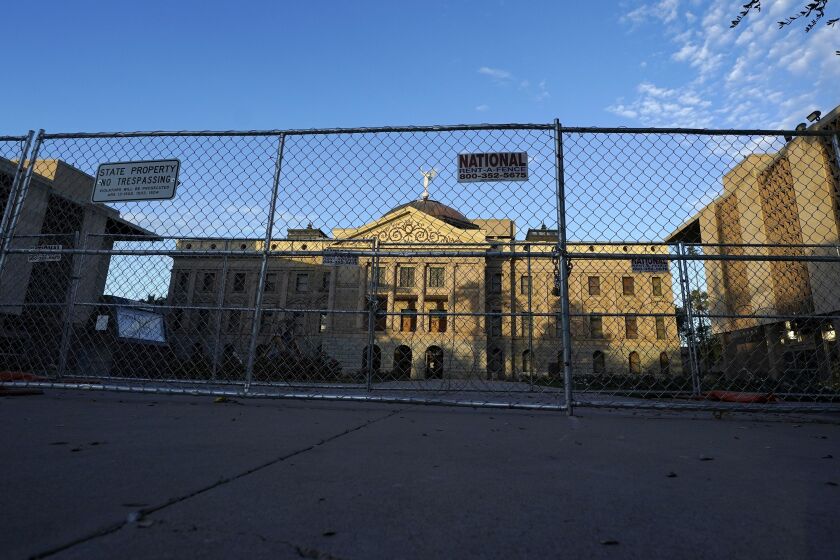Small groups of right-wing protesters — some of them carrying rifles — gathered outside newly fortified statehouses around the country Sunday as National Guard troops and police kept watch to prevent a repeat of the violence that erupted at the U.S. Capitol.
There were no immediate reports of any clashes.
Security was stepped up in recent days after the FBI warned of the potential for armed protests in Washington and at all 50 state capitol buildings ahead of President-elect Joe Biden’s inauguration on Wednesday.
A few people demonstrated in some capital cities, with crowds numbering in the dozens in some cases, but streets in many other places remained empty. Some protesters said they supported President Donald Trump. But others said they weren’t backing Trump and had instead come to voice their support for gun rights or oppose government overreach.
Some statehouses were surrounded by new protective fences, had boarded-up windows and were patrolled by extra police. Legislatures generally were not in session over the weekend.
Tall fences also surrounded the U.S. Capitol. The National Mall was closed to the public, and the mayor of Washington asked people not to visit. Some 25,000 National Guard troops from around the country are expected to arrive in the city in the coming days.
The security measures were intended to safeguard seats of government from the type of violence that broke out at the U.S. Capitol on Jan. 6, when far-right Trump supporters galvanized by his false claims that the election had been stolen from him stormed the building while Congress was certifying the Electoral College vote.
The attack left a Capitol Police officer and four others dead. More than 125 people have been arrested on charges related to the insurrection.
In Springfield, 250 Illinois National Guard members were activated, with some stationed at every intersection around the Illinois State Capitol and others placed at the entrance to the governor’s mansion. On Saturday, a “Back the Blue” pro-police rally had drawn just two participants, though organizers said they had told their followers to stay home this week because of the heavy police presence. No protestors were at the Illinois State Capitol early Sunday afternoon.
At the Ohio Statehouse on Sunday, about two dozen people, including several carrying long guns, protested outside under the watchful eyes of state troopers before dispersing as it began to snow.
Kathy Sherman, who was wearing a visor with “Trump” printed on it, said she supports the president but distanced herself from the mob that breached the U.S. Capitol.
“I’m here to support the right to voice a political view or opinion without fear of censorship, harassment or the threat of losing my job or being physically assaulted,” she said.
The roughly 20 protesters who showed up at Michigan’s Capitol, including some who were armed, were significantly outnumbered by law enforcement officers and media.
At Oregon’s Capitol, fewer than a dozen men wearing military-style outfits, black ski masks and helmets stood nearby with semiautomatic weapons slung across their bodies. Some had upside-down American flags and signs reading such things as “Disarm the government.”
At the Texas Capitol, Ben Hawk walked with about a dozen demonstrators up to the locked gates carrying a bullhorn and an AR-15 rifle hanging at the side of his camouflage pants. He condemned the insurrection at the U.S. Capitol and said he did not support Trump.
“All we came down here to do today was to discuss, gather, network and hang out. And it got blown and twisted completely out of proportion,” Hawk said.
At Nevada’s Capitol, where demonstrators supporting Trump have flocked most weekends in recent months, all was quiet except for a lone protester with a sign.
“Trump Lost. Be Adults. Go Home,” it read.
Authorities in some states said they had no specific indication that demonstrations would occur, much less turn violent. Yet many state officials vowed to be prepared.
One counter-protester came early to greet any demonstrators at the Pennsylvania Capitol, saying he had heard about the possibility of a meet-up of a far-right militant group. But no one else was there.
“I’m fundamentally against the potential protesters coming here to delegitimize the election, and I don’t want to be passive in expressing my disapproval of them coming into this city,” Stephen Rzonca said.
More than a third of governors had called out the National Guard to help protect their capitols and assist local law enforcement. Several governors declared states of emergency, and others closed their capitols to the public until after Biden’s inauguration.
Some legislatures also canceled sessions or pared back their work for the coming week.
Even before the violence at the Capitol, some statehouses had been the target of vandals and angry protesters during the past year.
Last spring, armed protesters entered the Michigan Capitol to object to coronavirus lockdowns. People angry over the death of George Floyd, who died after a Minneapolis police officer pressed a knee on his neck for several minutes, vandalized capitols in several states, including Colorado, Ohio, Texas and Wisconsin.
Last last month, crowds in Oregon forced their way into the state Capitol in Salem to protest its closure to the public during a special legislative session on coronavirus measures.
Anticipating the potential for violence in the coming week, the building’s first-floor windows were boarded up and the National Guard was deployed.
“The state Capitol has become a fortress,” said Oregon Senate President Peter Courtney, a Democrat. “I never thought I’d see that. It breaks my heart.”
Contributing: Sun-Times reporter Andrew Sullender in Springfield and Associated Press writers Scott Bauer in Madison, Wisconsin; Sam Metz in Carson City, Nevada; Gillian Flaccus in Salem, Oregon; Mike Householder and David Eggert in Lansing, Michigan; Meg Kinnard in Columbia, South Carolina; Marc Scolforo in Harrisburg, Pennsylvania; Angie Wang in Atlanta; Paul Weber in Austin, Texas; and Farnoush Amiri in Columbus, Ohio.








